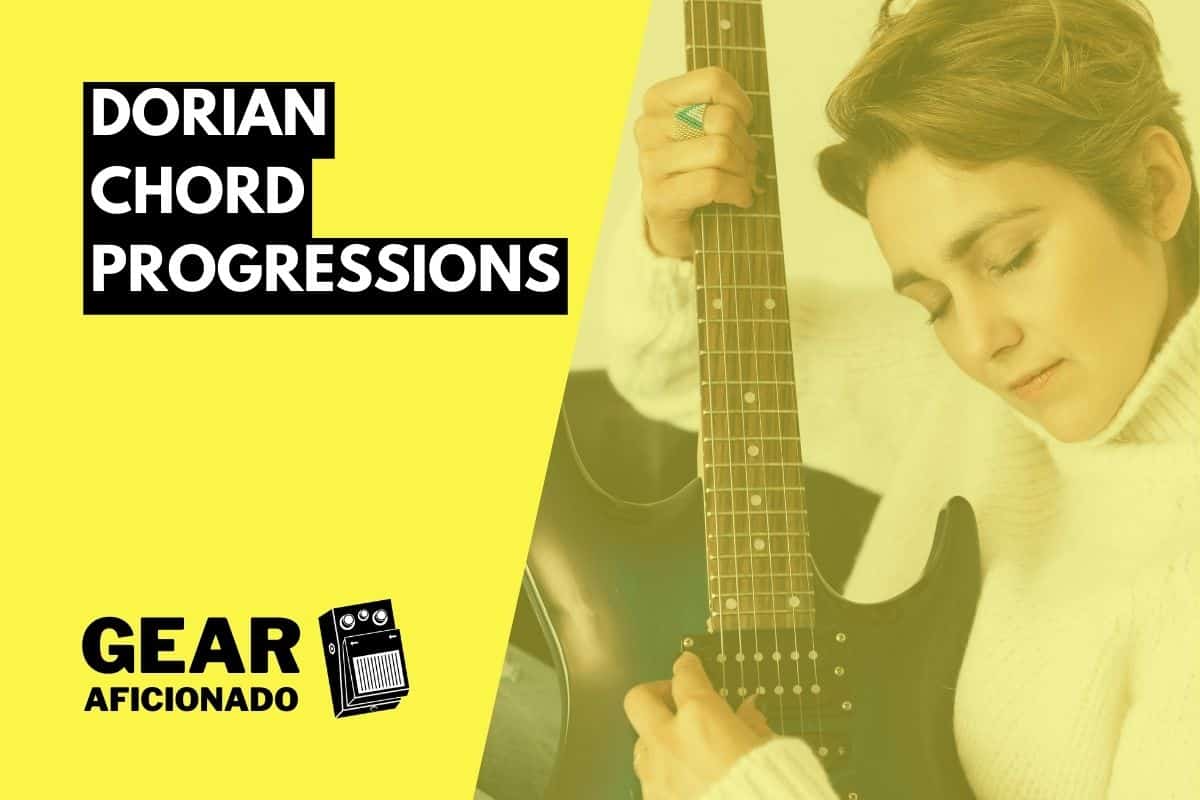Dorian is the unsung hero of melancholic songs.
Yes, this not-so-famous mode is capable of some emotional content and sits comfortably between the happiness of the Ionian mode and the sadness of the Aeolian mode.
More importantly, this is a mode that can serve you as an entirely new sonic universe, a map of stars that can inspire your future tunes giving them the emotional twist you need to haunt your audience.
There’s a lot to discover in the Dorian mode; it can be your secret sauce to take your compositions to the next level.
Follow me, you’re on a trip to songwriting stardom!
What is the Dorian Mode?
The Dorian mode is a minor mode that starts on the second degree of the major scale. It is also a symmetrical scale that can be played, for example, from D to D using only the white keys of the piano, for example.
As with any mode or diatonic scale, the Dorian mode can be turned into a notes scale so you can use it to compose solos and shred the night away, or it can also give us an assortment of chords to combine and create a song.
The Dorian mode can be a companion in your upcoming sonic adventures, but before you can use that secret sauce, you need to know how to put it together, what the chords are, the secret note, and some amazing chord progressions.
Read on because there’s a lot of information coming your way.
How Do We Put Together the Dorian Mode?
Let’s take the C major scale.
Why? Well, because using this scale means taking the version of the major scale that possesses no accidents (flats or sharps).
So, to put together the Dorian mode, we can take that same structure and start it from D.
Here’s the quintessential C Major scale:
| I | II | III | IV | V | VI | VII |
| C | D | E | F | G | A | B |
| W | W | H | W | w | W | H |
To create the perfect Dorian mode (no accidents such as flats and sharps) we should take the C Major scale and start it from the second degree.
The second degree of the C Major scale, as you can see, is D. That will be the first degree of the D Dorian we’re trying to construct.
You might have noticed a W and a H under the chords.
Well, these mean moving a whole tone (W) or half-a-tone (H).
Let’s take the same structure starting from D and let’s build our D Dorian.
| I | II | III | IV | V | VI | VII |
| D | E | F | G | A | B | C |
| W | H | W | W | W | H | W |
| 1 | 2 | b3 | 4 | 5 | 7 | b7 |
There we have it, that’s the formula to make our Dorian mode in any key we need to. For example, if we want to build the F Dorian, we can use the same W + H combination.
This is what we get:
| F | G | Ab | Bb | C | D | Eb |
What we have here are the notes that make up the D Dorian scale, but what we need to make chord progressions are chords!
So, how do we turn these notes into chords? Well, what we have to do is transform these notes into triads.
That’s exactly what comes up next.
These Are Our Chords
We need to form chords with the notes we have in our Dorian mode.
But how do we know what the quality of each chord is (minor, major, diminished)?
Well, let’s go back to our Major scale, shall we?
Let’s see what the chord layout in the C major scale is so we can deduct what the chord qualities in D Dorian are.
According to this structure, we have: major + minor + minor + major + major + minor + diminished. So, if we move the structure to the right, we start counting from the Dm.
That will give us a different formula: minor + minor + major + major + minor + diminished + major.
Therefore, the chords in our D Dorian scale will be:
| I | II | III | IV | V | VI | VII |
| Dm | Em | F | G | Am | Bdim | C |
So, these will be the chords we’ll be using to construct the best 7 Dorian chord progressions you’ve heard so far.
But first, let’s dive into a little secret that makes this mode so unique.
The “Raised Sixth” Is the Secret
The one thing that separates the Dorian mode from all the rest of the modes is the raised sixth.
This is not just a detail, but the most important aspect of this mode from an emotional point of view.
Let’s say that the happiest of all modes is the Ionian mode and the saddest of all modes is the Aeolian mode.
This is the formula for the Ionian mode:
| 1 | 2 | 3 | 4 | 5 | 6 | 7 |
This is the formula for the Aeolian mode:
| 1 | 2 | b3 | 4 | 5 | b6 | b7 |
The big differences that make one mode happy and chorus-friendly and the other sad and verse-friendly are the b3, b6, and b7 notes in the scale.
These transform the Aeolian mode (or minor scale) into an emotionally intense section in any song.
Now, let’s look at the formula for the Dorian mode:
| 1 | 2 | b3 | 4 | 5 | 7 | b7 |
So, as you can see, the b3 and the b7 are present in the Dorian mode, making it an emotionally loaded mode but the raised sixth, just like you can find it in the Ionian mode, pushes the Dorian progressions into upbeat, happy territory.
What is the human emotion that requires sadness and happiness to happen? Well, one thing I can think of right now is nostalgia.
But beyond the exact feeling or adjective, the important aspect of this emotional capacity of the Dorian mode is to think of it as a bittersweet mode that can help you get the most out of lyrics that talk about missing, longing, dreaming, and such.
So, while the happy Ionian Mode (or major scale) is great for grandiloquent choruses and the sad Aeolian mode (or minor scale) is great for insightful, bitter verses, the Dorian mode is perfect for an entire song or creating a cool bridge between the emotions in the verse and the emotions in the chorus.
PRO TIP: Using the chords in the scale that have the raised sixth in their triad is a great way to highlight this aspect of the mode. Therefore, whenever you can, use the II, IV, and VI degrees of the Dorian mode to give the bittersweet emotion a boost.
7 Amazing Dorian Chord Progressions
Now that you know what the Dorian mode is and how to create the chords in it, it’s time to put those new chords to work.
These are seven amazing Dorian chord progressions for you to put all you’ve just learned into practice.
1. i – IV – i
This is the most popular chord progression for the Dorian mode, and you can find it all over popular music.
It simply goes back and forth between the first and fourth degrees of the scale.
This is, by no means, a coincidence since the third note in the fourth degree of the scale is the raised sixth; therefore, it dyes the entire picture with the melancholy the Dorian mode is known for.
Finally, the first degree is a minor chord and the fourth is a major chord, which gives the progression another layer of emotional movement.
Songs using this progression are thousands, from “Oye Como Va” by Santana to “Uptown Funk” by Bruno Mars.
Moreover, this progression was the secret Pink Floyd used in songs like “The Wall Part II” among many others.
2. i – bVII – IV – i
This is a variation of the last progression adding the last chord in the mode before going to the IV but respecting the IV – i movement to generate closure and opening it up again.
Again, the choice of chords isn’t casual since the raised sixth in the chord gives it the quality it needs to engage the emotional factor.
A very well-known song with this progression is “Wicked Game” by Chris Isaak.
3. i – bIII – bVII – IV – i
This is another variation to the same idea of IV – I but with an increased level of sadness the progression adds the flat third.
4. i – bVII – i – bIII – i – IV
5. i – bIII – bVII – i – bVII
6. i – IV – i – bIII – V – IV – II – i
7. i – IV – V – bVII – i – bVI – V – bVII – i – II – IV – i
The Bottom End
Although not the most popular mode in the world, the Dorian mode can help you break the boundaries of your imagination and take a bold step into the emotional side of music.
Learn your way around this mode and let it be your secret weapon anytime your compositions need an extra dose of bittersweetness.
Happy (Dorian) playing!

Hello there, my name is Ramiro and I’ve been playing guitar for almost 20 years. I’m obsessed with everything gear-related and I thought it might be worth sharing it. From guitars, pedals, amps, and synths to studio gear and production tips, I hope you find what I post here useful, and I’ll try my best to keep it entertaining also.





